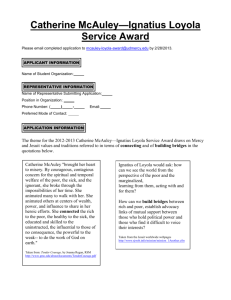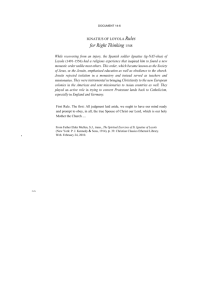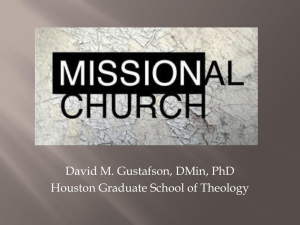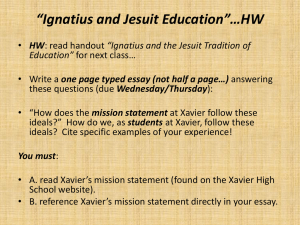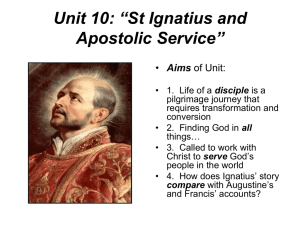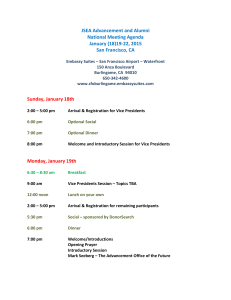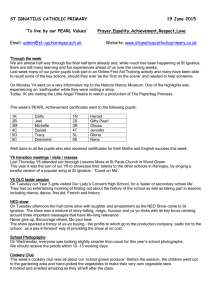Prologue
advertisement
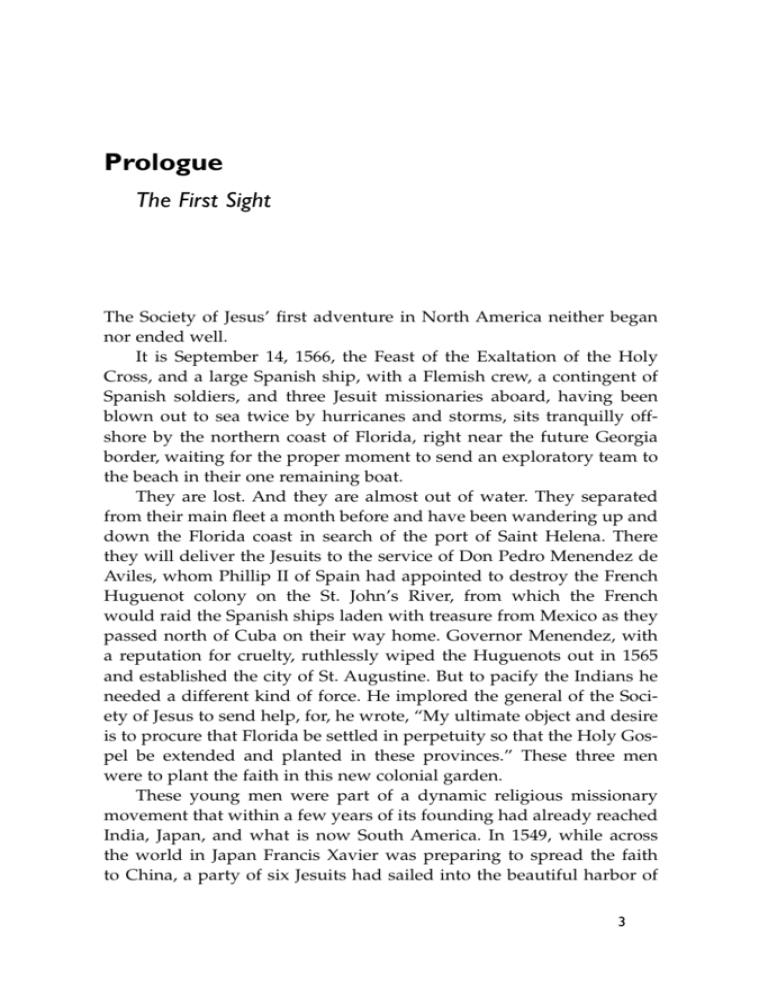
Prologue The First Sight The Society of Jesus’ first adventure in North America neither began nor ended well. It is September 14, 1566, the Feast of the Exaltation of the Holy Cross, and a large Spanish ship, with a Flemish crew, a contingent of Spanish soldiers, and three Jesuit missionaries aboard, having been blown out to sea twice by hurricanes and storms, sits tranquilly offshore by the northern coast of Florida, right near the future Georgia border, waiting for the proper moment to send an exploratory team to the beach in their one remaining boat. They are lost. And they are almost out of water. They separated from their main fleet a month before and have been wandering up and down the Florida coast in search of the port of Saint Helena. There they will deliver the Jesuits to the service of Don Pedro Menendez de Aviles, whom Phillip II of Spain had appointed to destroy the French Huguenot colony on the St. John’s River, from which the French would raid the Spanish ships laden with treasure from Mexico as they passed north of Cuba on their way home. Governor Menendez, with a reputation for cruelty, ruthlessly wiped the Huguenots out in 1565 and established the city of St. Augustine. But to pacify the Indians he needed a different kind of force. He implored the general of the Society of Jesus to send help, for, he wrote, “My ultimate object and desire is to procure that Florida be settled in perpetuity so that the Holy Gospel be extended and planted in these provinces.” These three men were to plant the faith in this new colonial garden. These young men were part of a dynamic religious missionary movement that within a few years of its founding had already reached India, Japan, and what is now South America. In 1549, while across the world in Japan Francis Xavier was preparing to spread the faith to China, a party of six Jesuits had sailed into the beautiful harbor of 3 4 Prologue Salvador de Bahia, Brazil. Men of various talents, they established a missionary method, a development strategy that would be the model for similar efforts throughout both South and North America: make the colony a bastion of civilized culture; establish schools for both the colonists’ children and the natives; teach them to write, to speak, to sing, and to pray. Then branch out through the jungles or to the frontier to native villages to teach and to baptize. Pedro Martinez, 35 years old, a Jesuit since 1553 and ordained in 1558, the religious superior of the band of three, stands on the deck overlooking the Florida coast, his eyes on the palm trees and the sand of this strange new land. For years he has pleaded with the Jesuit authorities to send him to the missions. Again and again he expressed his willingness—indeed his desire—to die for the faith. This is the greatest day of his life. The Pilgrim’s Journey The chain of events that brought Martinez to this spot began at the battle of Pamplona on May 20, 1521. There, in a skirmish between the troops of King Francis I of France and Charles V of Hapsburg, King of Spain and Holy Roman Emperor, a cannon ball smashed the right leg of a thirty-year-old Basque knight named Inigo Lopez de Loyola, who had, with foolhardy bravery, led a hopeless defense. His head turned by dreams of military glory, young Inigo had led the life of an occasional brawler, gambler, and libertine; but now those dreams were as shattered as the bones in his leg. His recuperation was long and painful, as the doctors were required to break his leg again, in a failed attempt to restore it to a shape that would still look good in a gentleman’s tight stocking. For who would follow a leader with a limp? We know Ignatius and his life through six sources: the Spiritual Exercises, based on notes he began in 1522; a collection of almost 7,000 letters; his Deliberations on Poverty and his Spiritual Diary from 1544 to 1545; the Constitutions of the Society of Jesus, composed in stages with the help of his secretary, Juan Polanco; and his brief autobiography on his early years dictated during his last year. Finally, there are the recollections of his colleagues who had gathered after his death. Perhaps the word which best captures Ignatius Loyola is pilgrim Prologue 5 —a term he applied to himself and which biographers agree catches his spirit. He was a traveler and seeker, a man in process, constantly analyzing his experiences and incorporating them into a unique vision that would touch the lives of millions and influence world history over the next 470 years. As he meticulously, scrupulously, moved through the steps of his personal conversion, without realizing it he was preparing to confront a Europe, a world, and a church that desperately needed what he would offer. Inigo, the name he kept until he felt the time had come to change, recuperated in the ancestral castle where he was born in 1491, in beautiful Guipuzcoa, his mountainous Basque country homeland in northern Spain. Deprived of the popular novels on chivalry he used to read, he read spiritual books like The Golden Legend, a popular collection of tales about the saints, and a scholarly life of Jesus by the Carthusian Ludolph of Saxony. The latter both summarized the Gospels and offered a theological interpretation of salvation history, God’s plan in which the Incarnation of the Word in Jesus rescues mankind from the consequences of Adam’s sin. As he read, Ignatius took notes that measured his emotional reactions to scenes in the life of Christ. He began to pray over what he was learning, to transform worldly ambitions of chivalry into a desire to serve a spiritual Lord. In February 1522 he slipped away from his castle, leaving his whole past behind, and went to the Benedictine monastery of Montserrat near Barcelona. There he confessed the sins of his whole life, discarded his fine clothes, put on a pilgrim’s tunic, and, imitating the vigil of knighthood, spent the night in prayer before the altar of the legendary “Black Virgin” statue—named for the color of its wood—of Our Lady. For the next eleven months he moved to nearby Manresa, where, living in a Dominican priory and retiring often to the solitude of a cave, he put himself through a series of experiments, penances, and prayers that raised his spiritual consciousness to a level of mysticism which eventually gave birth to the Spiritual Exercises, a systematic method of prayer and self-examination based largely on scenes from the life of Jesus — the instrument of personal transformation with which he would train his new “army.” He worked in hospitals with the poor, begged for his food, taught catechism to children, and struck up conversations wherever he went. These were the years in which Martin Luther’s rebellion led to his 6 Prologue excommunication in 1521; when Henry VIII was about to declare himself head of the Church of England; when a large percentage of bishops neglected their dioceses; when many priests didn’t even know the words for the consecration at mass, worked as day laborers, and didn’t know how to preach; when fewer than 5 percent of adults were as well educated as a seven-year-old today. Under these circumstances, a charming young man in a poor man’s clothes but with an aristocrat’s manner, who had read books and mastered some spiritual secrets, was an obvious attraction—including to well-bred women drawn by his piety and conversation. If it was an age of scandals, it was also an age of reform. Ignatius’s mysticism emerged from struggles with scruples that drove him to temptations to suicide, to profound illuminations—more intellectual experiences than images—including his understanding of the Trinity under the form of the harmony of three musical keys. He “saw” how God brought forth light at the creation and how Jesus was present in the Blessed Sacrament. Finally, on the banks of the Cardoner River, he formed an integrating picture of the purpose of his life: he would seek companions and labor for the good of others. So Inigo set out to Jerusalem where, in the custom of pilgrims, he retraced the footsteps of Christ. Then, at the age of 33, he moved first to Barcelona, and then to Alcala and Salamanca, to learn Latin and philosophy, to teach Christian doctrine to the large crowds he and his friends attracted, and to administer the early stages of the Exercises he had evolved in his notebooks at Manresa. But as was inevitable in the religious climate of 16th-century Spain, Inigo and his followers attracted the attention of the Inquisition. After all, he and his friends dressed alike, associated themselves with the poor, and, contrary to common practice, received communion every week. Were they members of the movement called “enlightened ones,” pseudo mystics who would undermine traditional piety? In Alcala, Inigo was hauled in and slapped into prison for 42 days, until he was found innocent; but the Inquisition ordered him to dress like other students and not speak in public until he had studied religion for four more years. In Salamanca he was arrested again within two weeks. Here the judges examined his manuscript of the Exercises and allowed him to teach again, but not to talk about the distinction between venial and mortal sin until he had completed more study. Inigo reacted with typical decisiveness. At the age of 37 he made Prologue 7 the trek to Paris and, surrounded by younger men, some of whom would become the first Jesuits, began studies that led to his Master of Arts degree in 1535. He improved his Latin, cut down on his ministries in order to emphasize his studies, which included lectures on Thomas Aquinas with the Dominicans and Aristotle’s physics, metaphysics, and ethics; but he still pursued those religious conversations which were the glue that began to fasten this extraordinary group of young men to one another. Significantly, it is also in his first year of serious studies that Ignatius changed his first name from Inigo to Ignacio or Ignatius—a decision which usually means that the person has come to see himself as somehow a new person and wants his public to see him in this same new light. The vision by the Cardoner River to serve the church was slowly taking concrete form in a group of students who now called themselves “friends in the Lord.” Two were Ignatius’s roommates—Pierre Favre from Savoy, studying for the priesthood, and the gallant fellow-Basque, Francis Xavier. In 1533 two young Spaniards, Diego Lainez and Alfonso Salmeron, joined the group. Lainez, whose great-grandfather has converted from Judaism, would eventually succeed Ignatius as the second general of the Society of Jesus and Salmeron would write a voluminous commentary on the New Testament. The following year, Nicolas de Bobadilla and Simao Rodrigues, both of whom would become the source of controversy within the Society 20 years later, made the friends in the Lord a band of seven. Most important, by the summer of 1534 all six had made the Spiritual Exercises—that is, led over thirty days stepby-step through its designated meditations and prayers—which by now had assumed close to their final form, with the Latin text about to be published as a manual, under Ignatius’s personal direction. How to Find God’s Will What does it mean to find God’s will? One of the differences between Jesuits and other religious orders and movements is the way in which the members come to know and identify with their founder. New Jesuits in their first year will certainly read one or more of the Ignatian biographies; but above all, through the Exercises, they will repeat the most formative experience of their founder’s life, and, through God’s 8 Prologue grace, thus undergo a transformation or conversion similar to his. Though they comprise a book, the Exercises are not to be read but done—just as a marathon runner will stretch, do push-ups, and run 40 miles every week in preparation for the big race. And the director, the person who presents the material to the “exercitant” or “retreatant” (the one making the Exercises), though he is similar to a coach, is less a teacher than a guide. The assumption is that if the retreatant will truly open his or her soul to grace, the Spirit will enter in and take over; the director’s role will be to help one hear what the Spirit is trying to say. Indeed, perhaps the most extraordinary aspect of Ignatius’s spirituality is his confidence that the Spirit does work directly in our lives and that, if we are free from “disordered attachments,” we will be able to read the Spirit’s movements by monitoring our feelings. Ignatius gives us a remarkable, even bizarre, example in his Autobiography. In February 1522, before his conversion was complete, Inigo met a Moor, like him riding on a mule. As they rode along together discussing religion, the Moor agreed that the Virgin Mary had conceived Jesus without a man, but could not believe she could still, giving birth, remain a virgin. Inigo tried to convince him, but failed, and the Moor rode on ahead. Very upset, Inigo feared he had failed to protect Our Lady’s honor; he decided to pursue the Moor and to stab him with his dagger. But as he approached the fork in the road that led to the town where the Moor was staying, Inigo had second thoughts. He would let the Lord decide—and the mule would be His instrument. At the turn, Inigo let the rains go slack and gave the mule his head. The mule passed up the road to the village and continued on the highway. The day-to-day steps of the Spiritual Exercises, which in their pure form take 30 days, divided into four “weeks,” replicate the steps of Inigo’s conversion to Ignatius, from the shattered leg to the Paris degree, from the brash cavalier devoted to his own glory to a humble pilgrim whose motto would be “Ad Majorem Dei Gloriam,” for the greater glory of God. The “weeks,” which vary in length depending on the degree of progress, begin with a Principle and Foundation, according to which we are to use all of God’s creation “insofar as” each object or person contributes to our salvation, followed by a detailed consideration of our sins, not in the morbid sense but in the context of God’s love and Christ’s sacrifice. The second week dwells on Jesus’ public life, which we view cine- Prologue 9 matically in our imagination: we see him cure the lame and the blind and hear his words in the Sermon on the Mount. The third focuses on the Passion, and the fourth, the shortest, on the Resurrection and Ascension. Throughout there are dramatic meditations designed to distinguish between valid and invalid “spirits,” or emotions that move us toward wise or unwise decisions, to render us indifferent to wealth and power, to seek suffering and humiliation if that will serve the needs of the apostolate, to help us “think with the Church,” and to follow Christ more zealously than we would any earthly prince or politician. In the process of “finding God’s will,” we do not presume that the more dramatically “religious” decision is the one God calls us to make. A young man might just as well finish his retreat determined to marry the girl next door and get a degree in accounting, or a young Jesuit may decide to leave the Society and become a journalist rather than volunteer for the missions. The final meditation, to “obtain the love of God,” is the heart of Ignatian spirituality. It catapults the retreatant back into the world, as if with “magic” spiritual glasses that enable him or her to view not merely the surface of things but the inevitable and universal presence of God constantly at work in His creation. Like Ignatius, the typical Jesuit will enjoy the countryside but love the cities, because here, in the thousands and millions teeming into the streets—poor and rich, young and old of every nation and color—God’s love is trying to break through, but needs help. The Company Is Formed On August 15, 1534, the feast of the Assumption of Mary, at a mass said by Pierre Favre, the seven united in a vow to become priests, to live lives of poverty, to go to Jerusalem, and to then offer themselves to the pope in Rome for whatever work would best serve the church. On June 24, 1537, the other six were ordained in Venice. They began to refer to themselves as the “Company of Jesus,” not as a military metaphor, but more to resemble the religious confraternities or brotherhoods of the time, and, of course, to present themselves literally as companions, not just of one another but of Jesus Christ himself who lived and worked through them. 10 Prologue The political climate canceled their trip to Palestine, so, after dispersing for a while to university towns with the hope of attracting more followers, they regrouped in Rome. On the outskirts, in a little chapel at La Storta, Ignatius was graced with another vision, in which Jesus, carrying his cross, asks Ignatius to serve Him, and the Father promises to “be propitious” to him in Rome. This experience confirmed Ignatius in their decision, in spite of criticisms, to name their company for Jesus. Their critics had followed them from Alcala to Paris and to Rome, objecting to the name, suggesting they might still be “Illuminati” or Lutherans in disguise, and, protesting their daily order that did not include the Divine Office, the Psalms, and breviary, sung eight times a day in choir, as in all the traditional religious orders. But the elimination of choir caught the essence of this new concept of the religious order. They meditated, said Mass, examined their consciences, and read their breviaries every day; but they were too busy finding God on the streets to spend another four or five hours a day in church. Furthermore, they were not monks, who took vows of stability that might implant them in one place for the rest of their lives. Their rule was to “travel to various places,” one reinforced by a special fourth vow to the pope to go wherever he might send them. In spite of all the questions raised and because the companions had made a strongly favorable impression by directing retreats based on the Exercises in Rome and had doubled their numbers to more than 20, after a year of deliberations, on September 27, 1540, Pope Paul III, in the bull Regimini militantis Ecclesiae, confirmed the establishment of the Society of Jesus. Ignatius’s pilgrim years were over. Elected as general for life, until his death in 1556 he governed from his office in Rome what became a worldwide educational and missionary organization during his lifetime. What about Women? It was during this time that a whole other aspect of his personality came to the fore—his administrative genius. Their Constitutions, the laws which would govern the election of Ignatius’s successor and the entire structure of the Society for years to come, took their final form, and the Ratio Studiorum, the practical compendium of teaching rules Prologue 11 that came to embody the Jesuit philosophy of education, took its early form. He governed from a tiny desk in a small upstairs apartment in Rome’s Church of the Gesu, writing thousands of letters to Jesuits and other men and women all over the world. A major concern was to establish norms for membership in the Society, since his administrative headaches made him wish he had been more selective in accepting recruits. According to a survey in the 1560s, the early Jesuits joined first to save their own souls and were attracted by the community affection of Jesuits they met. In time the main motive became to “help souls,” even at the cost of their own lives. The stories of two groups who sought membership have contemporary relevance: Jews and women. In 16th-century Spain there was a common prejudice that Jewish and Muslim converts to Christianity, known as “new Christians,” and their descendants were somehow inferior because of their “tainted blood,” and were therefore banned from church offices and religious orders. Ignatius, however, refused to go along with this notion. He expressed the wish that he could have Jewish blood so as to share in the lineage of Jesus and Mary; some of the most distinguished early Jesuits had descended from Jews. After his death, however, the Society, to its disgrace, in 1593 banned all those of “Hebrew and Saracen stock,” and did not lift the ban till 1947. Unlike the 20th-century American Jesuits, most of whom, prior to the 1960s, entered right after high school and spent their 20s with few opportunities to socialize with women, Ignatius knew many women as a courtier in his early life and worked closely with women on church projects, particularly in the Saint Martha Houses in Rome that he had founded, dedicated to the care and rehabilitation of prostitutes. At that time, women had very limited career opportunities: marriage, the convent, or prostitution. Laypersons who wanted to serve the church formed confraternities, religious associations guided by rules to perform good works: bury the executed, feed the poor, care for orphans, or promote special religious devotions. But following the Council of Trent, the church tended to channel women who wished to be active into religious orders, where the traditions of the cloister limited their activism. In 1542, Isabel Roser, a wealthy Barcelona noblewoman whose husband had died in 1541, set out for Rome with two women companions, determined to work under obedience with Ignatius. He put her in charge of a Martha House, which she referred to as a convent and 12 Prologue where she kept her servants and possessions. Her petition to Pope Paul III to be “admitted to the least Society of Jesus” was granted, and in 1545 she and two woman friends took a version of the vows of poverty, chastity, and obedience. They were Jesuits in the sense that they were vowed to obey Ignatius; but they lacked, for social and cultural reasons, the one quality Ignatius most required, what he called the “foot in the air” quality, the ability to “run freely from one place to another.” Lisa Fullam, in her essay in Studies in the Spirituality of Jesuits (November 1999) concludes that they in fact were the core of an essentially monastic second order under obedience to the Society. Within a year, Ignatius saw the experiment had failed and asked the pope to release them from their vows. They didn’t go quietly. Roser demanded the return of all the money she had given the Society; Ignatius responded with a bill for the 150 ducats she owed them. Eventually they were reconciled and resumed their correspondence. Roser joined a Franciscan convent, where she died in 1554. The story of Juana of Spain, the second daughter of Emperor Charles of Spain, married in 1552 to the heir to the throne of Portugal, is different. When her husband died in 1554 she asked to enter the Jesuits. She was nineteen. Problem: admit her and the Society angers the emperor; deny her and the Society angers the regent of Spain, who is Juana, appointed to that post by her father the emperor in 1554. After much discussion, the fathers decided that she should be admitted— but secretly. Hugo Rahner, editor of a monumental volume, Saint Ignatius Loyola: Letters to Women, concludes that Ignatius “took the princess’s vocation seriously” and also measured her spiritual progress. Today an observer might say she was a secret agent, a woman with great political influence in Spain who was also a member of the Society of Jesus and promoting its agenda. She died at age thirty-eight, still a member of the Society of Jesus, “the only woman known to have lived and died a Jesuit.” Professor Fullam concludes, “Most basically, the Jesuits decided that being a woman was not an absolute bar to membership in the Society.” The implications of this will return in the 20th century when the Society of Jesus will once again ask where do they stand with women. Meanwhile, men who started with teaching children catechism, establishing shelters for prostitutes, working in hospitals, preaching and hearing confessions, soon found themselves as theologians at the Council of Trent; administering a school system throughout Europe, Prologue 13 Asia, and the New World. They found themselves, like Xavier, dying on the little island of Sanchen waiting for a boat to China, or like Pedro Martinez, gazing anxiously at the Florida coast. The First to Die A historian would like to imagine a personal meeting between Ignatius Loyola and Pedro Martinez, but Ignatius spent most of his final years governing the Society from Rome and died there three years after Martinez entered. At the University of Valencia, Pedro was known for his quick wit, his mastery of Latin, his good grades in philosophy, but above all for his skill as a swordsman. As one of his friends wrote, “There was rarely a challenge or a duel in the city in which he was not principal, second or promoter.” He also seemed to despise the local Jesuits to whom his university friends were attracted, until one day, when he accompanied his friends to the Jesuit house in order to make fun of them, he was so impressed by their religious demeanor that he abruptly asked if he might join. The superior, Jerome Nadal, put him off for several months; but within a short time he was not only a minister of the novitiate, a college teacher, and a successful preacher, but on his way to Oran with 12,000 troops as a chaplain in the campaign against the Moors. He visited the sick and wounded, mastered the business management of religious communities, and was also a master cook. Afraid he was accepting too many administrative jobs without enough theological background, he studied more theology at Salamanca, then became rector at Valladolid, all the while pleading that because he could toil, bear hunger and thirst, sleep on the ground, speak Latin and read Hebrew, and, except for a week in Oran, had never been sick, he belonged in the missions. The summer of their voyage, Pedro, with his companions, Father Juan Rogel and Brother Francisco Villareal, prepared not just themselves but also the crews of the ships of the fleet for the expedition by preaching, hearing confessions, and exacting pledges from the sailors not to curse or use obscene language. Pedro taught himself to speak Flemish and the Flemish sailors to sing the catechism daily at noon. According to Rogel, the long voyage took on the atmosphere of a pilgrimage. 14 Prologue This September day, six Flemish sailors and two soldiers lower the boat into the water and board; then, in a panic, knowing the reputation of the barbarous Indian tribes that may await them, they refuse to go ashore unless Father Martinez goes with them. At this, as if accepting a challenge to a duel, Martinez springs into the boat and they row ashore. Then the ship is again blown out to sea. The reconnaissance party waits twelve days for it to return. They patrol the shore, first on foot, then by boat, looking for the fort. They are starving, but Martinez keeps their spirits up by holding his cross high and leading them in prayer. They follow a river inland and encounter small villages of friendly Indians who feed them. But on October 6, with one band of Indians, the mood changes. Thirty Indians surround the boat. Flores, a Spanish soldier, calls a warning: “These Indians mean trouble. Let us make off in the boat.” But Martinez hesitates; he will not desert the sailors who are some distance away. They call to the sailors. Flores reaches for his sword. The Indians grab Martinez and five others from behind and drag them into the river and shove them under. They drag Martinez out, half strangled, and as he raises his hands, club him to death. Flores and three others, wounded with arrows, escape in the boat to tell the story. For a number of reasons, the Jesuit mission in Florida did not succeed. In 1570 seven Jesuits moved their missionary effort north to the Chesapeake Bay, but within a few months the Indians turned against them and slew them all. In defeat again they withdrew to Havana, to the southwest, to Mexico and the Pacific coast, to labor where official Spanish presence offered some protection. Another generation would succeed where they first had failed. But neither Jesus Christ nor Ignatius Loyola had ever promised their followers success. They had offered their apostles only an opportunity for God’s glory, not their own. In 1634 a new colony that included Jesuits would settle in Maryland; in the 1640s French Jesuits would pour down from Canada; and in the 1680s an Italian Jesuit with Spanish backing would open Arizona and Southern California. Meanwhile the first Jesuit blood had been spilled in what would become, within a little more than 200 years, the United States of America.
